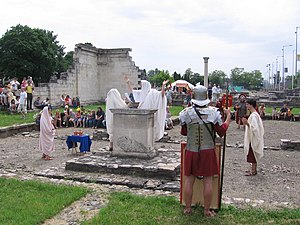
Revivals of the ancient Roman polytheistic religion have occurred in several forms in modern times. Seeking to revive traditional Roman cults and mores, they have been known under various names including cultus deorum Romanorum (worship of the Roman gods), religio Romana (Roman religion), the Roman way to the gods (Italian: Via romana agli dei), Roman-Italic Religion and Gentile Roman Religion. A number of loosely related organizations have been created during the contemporary period.[1][2]
History
[edit]Interest in reviving ancient Roman religious traditions dates from the Renaissance. People such as Gemistus Pletho and Julius Pomponius Laetus were early advocates.[1] In 19th century Italy, the fall of the Papal States and the process of Italian unification led to anti-clerical sentiments in the intelligentsia. Some Italian intellectuals considered that a revival of Roman polytheism was a serious alternative to Roman Catholicism. People such as the archaeologist Giacomo Boni and the writer Roggero Musmeci Ferrari Bravo promoted the restoration of Roman cults and mores.[3][4] Some of the religious revivalists were interested in occultism, Pythagoreanism and Freemasonry; these included Amedeo Rocco Armentano, Arturo Reghini and Giulio Parise. In 1914, Reghini published the article "Imperialismo Pagano" (lit. 'Pagan Imperialism') where he argued for the existence of an unbroken initiatory lineage in Italy, connecting ancient Roman religion to modern times through people like Numa Pompilius, Virgil, Dante Alighieri and Giuseppe Mazzini.[5]
The attempts to revive or revitalize Roman cults coincided with the rise of the National Fascist Party and several of the polytheists tried to ally themselves with fascism. This ended in 1929 when Benito Mussolini and Pope Pius XI signed the Lateran Treaty, leaving polytheists such as Musmeci and Reghini embittered with fascism.[3][6] Loosely influenced by Reghini's and Julius Evola's Ur Group of the 1920s, various groups have appeared in Italy during the contemporary period, most notably Associazione Tradizionale Pietas (since 2005), the Roman Traditional Movement and Curia Romana Patrum in the 1980s, which unified some calendars.[7]
In the 2000s, the Associazione Tradizionale Pietas[8] has been engaged in the reconstruction of several temples[9] throughout Italy and has initiated the legal process to obtain recognition from the State, drawing inspiration from similar organizations in other European countries, such as the Thyrsus and YSEE associations in Greece. On June 30, 2023, Pietas participated in the ECER meeting, where delegations from associations from 17 nations drafted and signed the Riga Declaration,[10] aimed at urging the governments of various organizations to recognize European ethnic religions. Furthermore, since the beginning of the new millennium, some groups have resumed performing public rituals such as the ritual on the day of Parilia.[11][12][13]
Inspired by the Roman Traditional Movement and by the Supreme Council of Ethnic Hellenes, the idea of Roman religious practice in modern times spread outside Italy into countries of European or Western culture. Practitioners of the ancient Roman religion can be found especially across Latin Europe and in the Americas. The most notable international organization of reconstructionist Roman religion is Nova Roma, founded in 1998, which has active groups in every continent.[14]
See also
[edit]References
[edit]- ^ a b Marré, Davide (2008). "Tradizione Romana" [Roman tradition]. In Marré, Davide (ed.). L'Essenza del Neopaganesimo [The essence of neopaganism] (in Italian). Milan: Circolo dei Trivi. pp. 35–37.
- ^ Angelini, Andrea (22 January 2019). "The Roman Way To The Gods: The Ancients Are Back". Italics Magazine. Retrieved 28 August 2021.
- ^ a b Giudice, Christian (2012). "Pagan Rome was Rebuilt in a Play: Roggero Musmeci Ferrari Bravo and the Representation of Rumon". The Pomegranate. 14 (2): 212–232. doi:10.1558/pome.v14i2.212. ISSN 1743-1735.
- ^ Buscemi, Francesco (2019). "The Sin of Eating Meat: Fascism, Nazism and the Construction of Sacred Vegetarianism". In Gentilcore, David; Smith, Matthew (eds.). Proteins, Pathologies and Politics: Dietary Innovation and Disease from the Nineteenth Century. London: Bloomsbury Publishing. p. 144. ISBN 978-1-3500-5686-2.
- ^ Giudice, Christian (14 October 2016). Occultism and Traditionalism: Arturo Reghini and the Antimodern Reaction in Early Twentieth-Century Italy (PhD). University of Gothenburg. pp. 19–20. Retrieved 19 August 2021.
- ^ Lloyd Thomas, Dana (2006). "Reghini, Arturo". In Hanegraaff, Wouter (ed.). Dictionary of Gnosis & Western Esotericism. Leiden and Boston: Brill. pp. 979–980. ISBN 978-90-04-15231-1.
- ^ Mark Sedgwick, Against the Modern World: Traditionalism and the Secret Intellectual History of the Twentieth Century, (2004) p. 187
- ^ Castagnetto, A.M. and Palmisano, S. (2021) ‘Beyond monotheism. Topics, groups and political interpretations of neo-paganism in Italy’, Polis (Bologna, Italy), 36(3), pp. 413-. Available at: https://doi.org/10.1424/102289.
- ^ "Culto e cultura nel segno della dea: Sorge a Taranto il tempio di Minerva".
- ^ "riga declaration | Search Results | ECER". 2023-07-04. Retrieved 2024-05-04.
- ^ "PROGRAM". GRUPPO STORICO ROMANO. Retrieved 2024-05-04.
- ^ "Gruppo Storico Romano for the 2777th Natale di Roma". Turismo Roma (in Italian). 2024-04-12. Retrieved 2024-05-04.
- ^ "Natale di Roma all'ETRU". www.museoetru.it (in Italian). Retrieved 2024-05-04.
- ^ George D. Chryssides, Historical Dictionary of New Religious Movements (2011, 2nd ed.)
Further reading
[edit]- Hakl, Hans Thomas (2009). "Das Neuheidentum der römisch-italischen Tradition. Von der Antike in die Gegenwart" [Neopaganism of the Roman-Italic tradition: from antiquity to the present]. In Gründer, René; Schetsche, Michael; Schmied-Knittel, Ina (eds.). Der andere Glaube. Europäische Alternativreligionen zwischen heidnischer Spiritualität und christlicher Leitkultur [The other faith: European alternative religions between pagan spirituality and Christian dominant culture]. Grenzüberschreitungen (in German). Vol. 8. Würzburg: Ergon. pp. 57–76. ISBN 978-3-89913-688-3.
- Barbea, Giuseppe (2 June 2021). Pietas: An Introduction to Roman Traditionalism (2nd. ed.). Mythology Corner. p. 244. ISBN 9780981759616. Retrieved 2 May 2024.
External links
[edit]- Nova Roma (international worldwide organization)
- Pietas Traditional Association (in Italian)
- Movimento Tradizionale Romano (in Italian)
| Approaches | |||||
|---|---|---|---|---|---|
| Arts and institutions | |||||
| By country or region | |||||
| Movements (list) |
| ||||
| In society | |||||
| Related articles | |||||